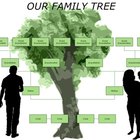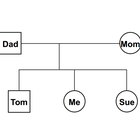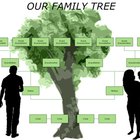On the surface, family trees sound simple, but unfortunately this isn't always the case. Once a family starts to involve ex spouses, second spouses and step and half-siblings, condensing it into a family tree can get complicated. But there are ways to include former spouses in a family tree without making things too messy.
Designing Your Own Tree
There are official standard methods of creating generation charts of biological ancestors, but if you're putting together a family tree for personal reasons, you can have a lot more freedom with it. You can even design your own key to indicate the different types of relationships in your family tree – for instance, a dotted horizontal line might represent a dissolved marriage, while a solid one means the marriage is still standing. One of the most common ways of denoting a divorced couple is to draw a horizontal line between the two ex spouses and insert a diagonal line into the horizontal line to symbolize divorce.
When to Include Ex Spouses
If you're creating your family tree for purely genealogical purposes, you need to include former spouses only if they involve a biological relation to you, such as a half-sibling. Some genealogy charts, like five-generation ancestor charts, include only ancestors and exclude siblings, meaning you'd include all of your ancestors regardless of whether they remained married, and you'd leave out any of their spouses who aren't your direct ancestors. However, if you're designing your own family tree and would like to include former spouses for personal reasons, you may do so at your own discretion.
Denoting Sibling Relationships
Where there's a family with multiple marriages, there are often varying types of sibling relationships: full siblings, half-siblings and step-siblings. There are a few ways to indicate these relationships on your family tree. Consider a half-sibling relationship, for example. Perhaps your mother and father divorced after having one child (you), and then your mother remarried and had another child. The second child would be your half-sibling on your mother's side.
You would draw this section of your family tree as follows: Connect your mother and father with a horizontal line, then draw a vertical line downward from their relationship to the symbol representing you, their child. Insert a diagonal line through your parents' connecting horizontal line to represent their divorce. Add a horizontal line between your mother and her current husband, then a vertical line downward from their relationship to a symbol representing your half-sibling.
For a step-sibling, structure your family tree similarly, except draw the vertical line downward from your step-parent's symbol to your step-sibling's symbol. This indicates that the sibling is not biologically related to either of your parents.
Related Articles

How to Create a Family Tree That ...

How to Make a Genogram Chart

How to Make a Family Tree for the 5th ...

How to Do a Genogram

Wedding Etiquette for a Step-Grandmother

How to Draw Genograms

How to Draw a Family Tree When There Is ...

Family Tree Rules

How to Construct a Kinship Diagram

What Is an Affinal Kinship?

What Is a First-Degree Relative?

How to List Stepparents in a Wedding ...

The Difference Between First and Second ...

How to Find Twins on Pedigree Charts

How to Make a Free Genogram

How Do You Address Wedding Invitations ...

How to Give a Written Analysis of a ...

The Effects of Separation & Divorce on ...

What Is a Paternal Family Tree?

Parents of the Groom Wedding Toasts
References
Writer Bio
Brenna Swanston is a freelance writer, editor and journalist. She covers topics including environment, education, agriculture, travel, immigration and religion. She previously reported for the Sun newspaper in Santa Maria, Calif., and holds a bachelor's in journalism from California Polytechnic State University. Swanston is an avid traveler and loves jazz, yoga and craft beer.